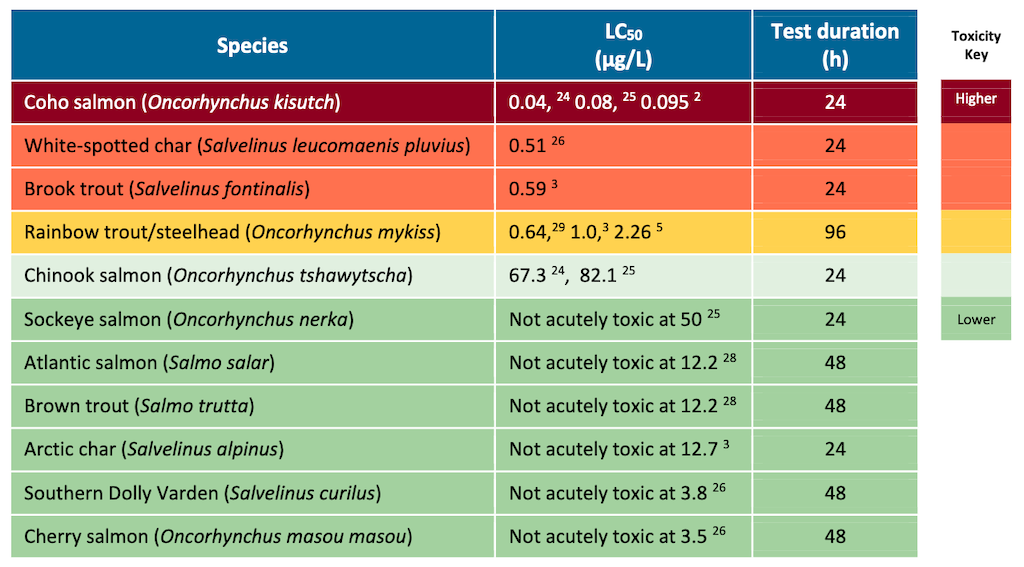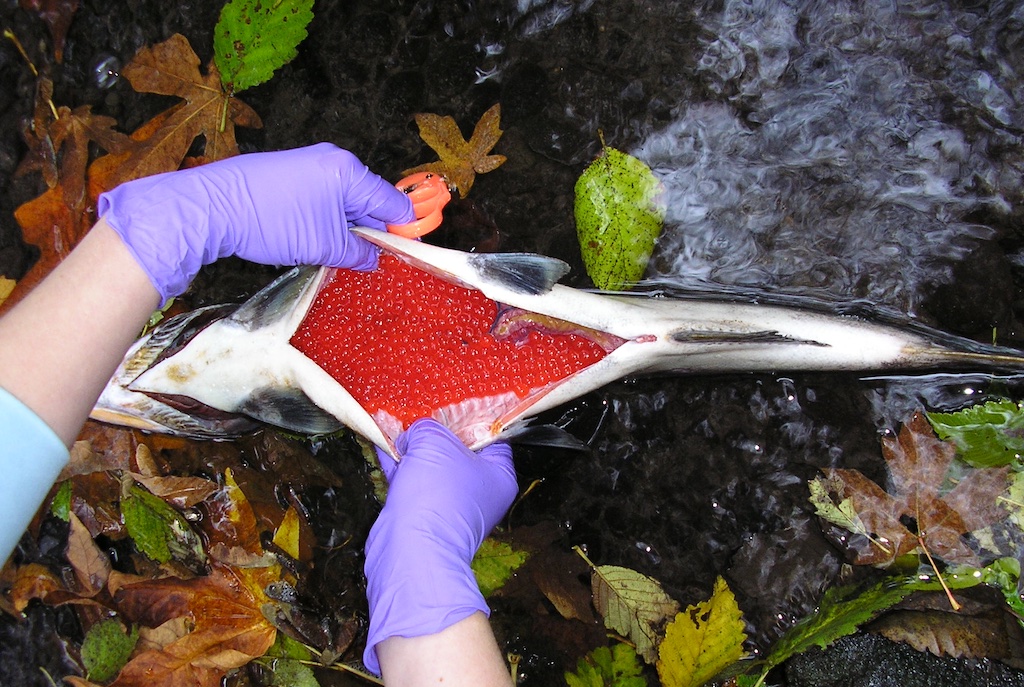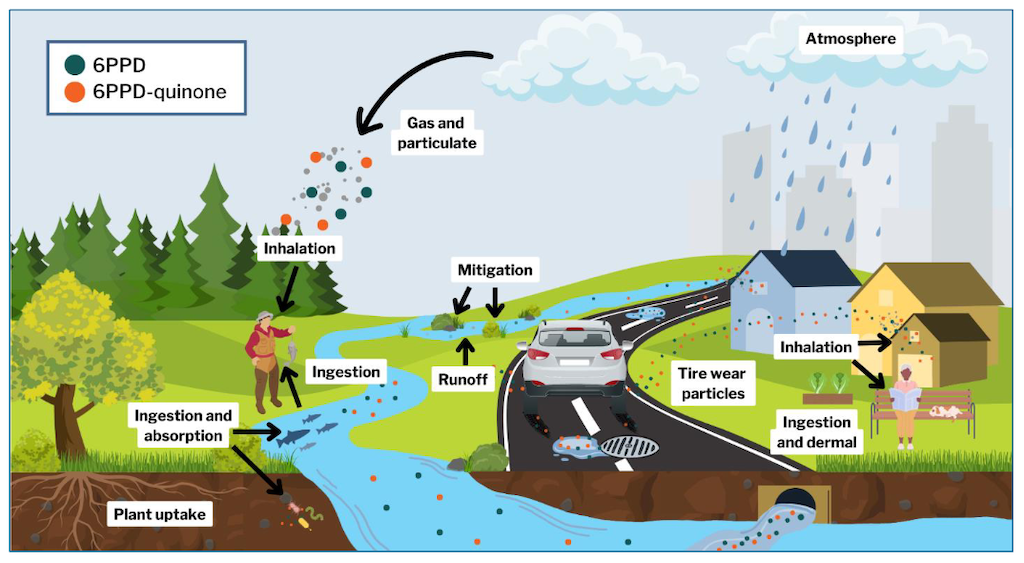A tire-related chemical found to kill coho salmon and other fish has come under intense worldwide investigation ever since Puget Sound researchers isolated the singular compound three years ago from among thousands of pollutants residing in stormwater.
The chemical, 6PPD-quinone (6PPD-Q), was virtually unknown until its isolation in 2020. Now, it is recognized as one of the most toxic chemicals ever seen in the aquatic environment. Scientists from at least 10 countries have been measuring its effects on a variety of fish and other organisms. Meanwhile, other researchers have been probing the chemical’s influence and damage at the cellular level. In rapid succession, dozens of reports in scientific journals have described some remarkable findings — and yet much about 6PPD-Q remains unexplained.
Coho, the most sensitive species identified so far, first tipped off researchers to the toxicity problem more than 20 years ago, when coho were keeling over and dying before they could spawn in streams polluted with stormwater. Eventually, environmental chemists from the Center for Urban Waters, affiliated with the University of Washington-Tacoma and the Puget Sound Institute used advanced analytical techniques to separate and identify the chemical, shown to come from fragments of automobile tires. A torrent of scientific investigations quickly followed. (For the full story, see the Encyclopedia of Puget Sound.) [Editor’s note: The Puget Sound Institute is the publisher of the Encyclopedia of Puget Sound and Salish Sea Currents.]

A returning coho salmon at the Suquamish Tribe's Grovers Creek Hatchery. Photo: K. King / USFWS (CC BY-NC 2.0)
Nat Scholz, a marine zoologist with NOAA’s Northwest Fisheries Science Center, said the widespread response to the announcement was a likely result of the extreme toxicity of the newly identified chemical as well its ubiquitous nature, given that automobile tires are nearly everywhere on Earth.
“It certainly has been a big response, much bigger than the geographic focus we have had here for the past 20 years,” said Scholz, one of the first researchers to study the mass mortality of coho observed in Seattle streams polluted with road runoff.
One of the most perplexing aspects of this ongoing research relates to the vastly different effects of 6PPD-Q on various species. If coho are the most sensitive to the chemical, toxicologists might expect similar results for closely related species, such as Chinook salmon. But that’s not the case. Coho are about 800 times more sensitive than Chinook, based on deadly concentrations reported in studies.
On the other hand, more distant salmonids on the evolutionary scale, specifically brook trout, rainbow trout and white-spotted char, are among the few species found to be especially sensitive to the chemical. So far, all the sensitive species are in the family Salmonidae, but plenty of fish species have not been put to the test.

Coho salmon, the most sensitive species to 6PPD-Q identified to date, top this list of example fish species from very high to low across a toxicity gradient based on the LC50 value (the amount of chemical that causes death in 50% of fish tested). Source: ITRC 2023.
Scientists say no clear patterns have been discerned to explain why some species are more sensitive than others. Some salmonids show no effects at all to concentrations much higher than ever found in streams. They include Atlantic salmon; brown trout; Arctic char; and two types of Asiatic salmon: cherry trout and southern Dolly Varden. Chum salmon also are known to swim around freely in tanks of stormwater that would kill coho within an hour.
As researchers examine the physiological effects of 6PPD-Q on various species, they remain acutely aware that any explanation must account for the vast differences in toxic effects among a wide variety of species. They also recognize individual variations within each species. That is, a few juvenile coho may survive in an experiment using a concentration of 6PPD-Q that kills the vast majority of fish. Individual sensitivities are common in most species, experts say, just as some people are more sensitive to certain drugs.
While some toxicologists examine sensitive salmonids for damage at the cellular level, others are looking for subtle changes among less sensitive species. For example, newly hatched zebrafish, a common experimental species, appear to change their exploratory behaviors, sleep cycles and heart rates in the presence of 6PPD-Q at concentrations that seem to have little effect on adult zebrafish, as reported by Spanish researchers in the journal Science of the Total Environment. Related studies have revealed an apparent disruption in hormones involving growth and development in zebrafish, as reported by Chinese scientists in the journal Ecotoxicology and Environmental Safety.
A wide range of scientists have expressed ongoing concerns about such “sublethal effects,” which can reduce an animal’s fitness without killing it outright. Researchers are considering effects on growth, development, reproduction, as well as susceptibility to environmental stresses such as disease, pollution and warming waters. Sublethal effects of 6PPD-Q are important, experts say, particularly for salmon and trout, because numerous species throughout the Northwest are officially at risk of extinction under the Endangered Species Act.
Exposure to toxic compounds in streams could potentially affect population viability of vulnerable species even without signs of widespread mortality, toxicologists say. While 6PPD-Q may be one of the most toxic chemicals released into the environment today, many streams contain a multitude of other chemical assailants.
While most research has focused on fish and aquatic organisms, serious questions have been raised about the potential effects of 6PPD-Q on humans. So far, only a few studies have reported results, mainly confirming that the compound can be found in the blood and urine of people.
One frequently cited report from the South China region revealed 6PPD-Q in the urine of nearly all of the 150 people tested in the region, with much higher concentrations in the urine of pregnant women, compared to groups of adults and children. One possible explanation is that pregnancy increases metabolism, allowing these women to excrete the chemical from their systems more quickly. A likely source of exposure is air pollution, the researchers say.
The article, published in Environmental Science and Technology Letters, concluded with this: “Considering that 6PPD-Q was a lethal toxicant to multiple aquatic species, the potential human health risks posed by its long-term exposure require urgent attention.”
Penetrating the blood-brain barrier
In the 1980s, when scientists first observed the dance of death among coho afflicted with unknown toxicants, they frequently observed the fish swimming in circles or in random directions at the water’s surface, mouths wide open in a most unnatural manner. Eventually the fish would lose all control, roll over and float downstream until they died.
One study in Seattle’s Longfellow Creek showed that between 60 and 100 percent of female coho were dying each year before they could spawn. This acute poisoning came to be known as “pre-spawn mortality syndrome,” later renamed "urban runoff mortality syndrome" because of the strong connection to stormwater.

An adult female coho affected by urban runoff mortality syndrome died before spawning in Longfellow Creek in the fall of 2005. Photo: Tiffany Linbo, NOAA Fisheries
Jen McIntyre, a toxicologist at Washington State University’s Puyallup Research and Extension Center, has been studying the effects of polluted stormwater on fish for nearly 20 years. Investigating the effects of 6PPD-Q, she and her fellow researchers turned their attention to the vascular system, which carries oxygen and nutrients throughout the body. After all, the outward symptoms of gasping for air point to a lack of oxygen that could trigger neurological effects, including loss of physical control.
One study from McIntyre’s lab revealed that the 6PPD-Q somehow triggers leakage from blood vessels into the tissues — including the brains of affected fish. Normally, the brain is protected from invasion by tightly linked cells, creating a blood-brain barrier. But leakage of foreign substances into the brain — as revealed by infusing a special dye into the fish — could produce serious repercussions, according to a report by Stephanie Blair, published in the Canadian Journal of Fisheries and Aquatic Sciences. The researchers also noted leakage in the gills, which could affect respiration.
“We think the brain is important because that is the source of everything the body does,” McIntyre said. “If chemical soups can be released into the brain, that could cause all sorts of problems.”
Picking up on the idea of vascular leakage, Justin Greer, a toxicologist with the U.S. Geological Survey in Seattle, began studying cellular responses to 6PPD-Q in the tissues of newly hatched coho salmon by focusing on genes activated and deactivated by chemical exposure. Messenger RNA, a key to the production of proteins and enzymes, was fully transcribed in the exposed fish, allowing a comparison to unexposed fish. Some 1,822 genes found to be involved in the chemical response were sorted into seven groups, each having identified effects on the fish.
For example, one powerful effect revealed by the study involved the blood-brain barrier, a critical component of a healthy nervous system. Greer found that 6PPD-Q disrupted the production of proteins regulating the tightness between endothelial cells that line blood vessels and the blood-brain barrier. The effect was to loosen the spaces between the cells and allow foreign chemicals to invade the brain, as well as other tissues.
The study, published in the journal Environmental Science and Technology, also found alterations in the production of enzymes influencing inflammation and related cellular functions that also can affect the blood-brain barrier. In addition, proteins involved in the maintenance of the blood-brain barrier were affected, along with blood-related pathways such as coagulation. All these findings lead to an increased potential for leakage into the brain, organs and other tissues.
Effects on the brain may offer a general explanation for the symptoms, McIntyre noted, but researchers need to know more about how the brain is affected, as well as the steps leading from initial absorption of the chemical. It is possible that the leakage from blood vessels is a “downstream effect” of the toxic response during an enzymatic interplay within the body. Studies are ongoing to see if 6PPD-Q is acting directly on the cells or, more likely, setting off biochemical reactions that can lead to adverse effects within the brain.
Energy for cellular function
Meanwhile, other researchers are focusing on biochemical pathways that produce the raw energy needed to fuel bodily functions. Normally, cells produce energy through a major metabolic pathway involving glucose from food and oxygen from respiration. But toxic substances have been known to disrupt this key metabolic pathway and prevent the cells from utilizing available oxygen, thus leading to a type of internal suffocation.
Markus Brinkmann, a toxicologist at the University of Saskatchewan in Canada, noted from experiments in his lab as well as from other reported studies that the chemical seemed to increase glucose levels, red-blood-cell counts and oxygen consumption, in some if not all fish.
“All of that to us suggested that the mechanism might be related to energy metabolism in the widest sense,” Brinkmann said.
In 2020, when news broke that UW scientists had isolated 6PPD-Q from compounds found in tires, Brinkmann was already involved in studies looking at constituents of stormwater from the city of Saskatoon. He knew that tire chemicals were a concern, and he quickly reached out to Ed Kolodziej, an environmental engineer who was leading the UW research effort.
“One thing led to the other,” Brinkmann said, adding that his interest was piqued by the “puzzling species differences in sensitivity” along with questions about how the chemical might be affecting inland salmonids, including trout species. The University of Saskatchewan’s Toxicology Center is well-suited to study these questions, he added, “and it was clear to us that we had to get involved in this research.”
In looking at cellular energetics, graduate student Hannah Mahoney conducted experiments on two laboratory-grown cell lines from rainbow trout, namely gill cells and liver cells. In gill cells, the oxygen consumption rate increased according to 6PPD-Q concentrations, presumably because the cells were no longer able to use the available oxygen efficiently. In contrast, oxygen consumption did not change in the liver cells (Environmental Science and Technology Letters).
Meanwhile, the researchers also looked at the chemical breakdown of 6PPD-Q in the body, a process called biotransformation, which produces other chemicals, known as metabolites. A measurement of 6PPD-Q and its metabolites showed that the gill cells had converted almost none of the parent compound into metabolites, but considerable biotransformation had taken place in the liver.
“We speculated that the absence of biotransformation in the gill might actually be the reason that you see those effects on the oxygen-consumption rate in the gill cell line, not the liver cell line,” Brinkmann said, adding that those findings inspired a deeper look at the effect of the chemical on the circulatory and respiratory systems.
Summer Selinger, another graduate student on Brinkmann’s team, measured oxygen consumption, heart function and blood composition in two fish. One is Arctic char, shown to be insensitive to 6PPD-Q, along with rainbow trout, a highly sensitive species.
In the tolerant Arctic char, no major changes were seen in normal circulatory functions. But in the sensitive rainbow trout, oxygenated hemoglobin decreased, making oxygen less available for normal functions. At the same time, Selinger saw an increase in deoxy-hemoglobin, the form essentially searching for oxygen to carry along in the blood. And she saw an even more dramatic increase in met-hemoglobin, an undesirable form that has been chemically blocked from taking up oxygen.
These findings, yet to be published, support what observers have been seeing in the behavior of fish affected by the chemical, Brinkmann said, “almost as if they were suffocating from within.”
As another indication of physiological imbalance, the chemical also seemed to increase the heart rate in rainbow trout but not in Arctic char.
Brinkmann’s lab also conducted comparative genomic studies looking at a host of genes that became deactivated in the presence of 6PPD-Q. Researcher Catherine Roberts observed very distinct differences between sensitive and tolerant species. Using advanced modeling techniques and statistical analysis, the research team was able to organize the deactivated genes into affected biochemical pathways. The primary affected pathways seemed to be systems that regulate immune system stress and inflammation, systems that promote cell development, and systems involving cell death.
Interestingly, the modeling approach — which provides theoretical benchmark doses for the various effects — produced results that were fairly close to the effective doses shown in actual fish measured in previous experiments, said Brinkmann.
The rapid response to the chemical by living fish, along with the new genetic evidence, supports the idea that disruption could be taking place along the major biochemical pathways that produce energy for cellular function, Brinkmann said, but he stressed that neurological effects being studied in other labs could trigger a similar response.
Fitting all these pieces together — including effects on the blood-brain barrier — will require more research, Brinkmann said. New discoveries about the developmental effects on sensitive fish soon after they hatch have been setting off loud alarm bells. Genetic findings reflect some of the earliest studies on coho salmon embryos, which revealed that stormwater can reduce the length of coho and the size of their eyes. These effects could impair their ability to avoid predators.
Even low concentrations of 6PPD-Q might lead to early deformities and reduced long-term fitness in fish that somehow survive one or more exposures to the chemical. Further studies are expected to characterize these sublethal effects on a variety of fish and eventually other species, including humans.
The role of the liver in detoxification
Stark differences in sensitivity to 6PPD-Q among various species might be explained by significant differences in tissues and enzymes from one species to the next. Such differences, if they exist, could lead to varying levels of direct damage from the chemical. But another issue could be a critical factor: How quickly can an animal detoxify 6PPD-Q after it enters its body? Several studies suggest that species more tolerant to the chemical could be the ones most successful at detoxification — a primary role of the liver — thus leaving the fish less vulnerable to toxic attacks on other organs.
David Montgomery, a graduate student researcher in toxicology at the University of Saskatchewan, has been studying what happens to 6PPD-Q in the livers of various salmonids, some sensitive and some tolerant to the chemical. The more tolerant species were shown to have higher levels of metabolites, produced when chemicals in the body react with 6PPD-Q. These metabolites, created as part of the liver’s detoxification process, are less-toxic “transformational compounds.” Generally, Montgomery found the highest levels of metabolites in the most tolerant species, with metabolite levels decreasing as he tested fish with increasing sensitivity to 6PPD-Q.
The most plausible explanation for these different levels of metabolites, according to Montgomery, is that tolerant species contain more of the enzymes needed to transform 6PPD-Q to less-toxic metabolites. This is still a hypothesis, he stressed, and more investigation is needed to identify the enzymes responsible for the biotransformation.
Of mice and humans
To better understand how 6PPD-Q might affect humans and other mammals, some researchers have begun exposing mice to the chemical and looking for effects. Jing Zhang, a toxicologist at Hong Kong Baptist University, found that 6PPD-Q fed to mice was rapidly absorbed into the blood and then circulated to various parts of the body, which showed differing concentrations. The highest levels were found in the fatty adipose tissues. Peak levels in the blood were reached in less than an hour, with the chemical penetrating the blood-brain barrier within half an hour, according to the study published in the journal Science of the Total Environment.
In a limited study, patients with Parkinson’s turned out to have significantly higher concentrations of the chemical 6PPD-Q around their brains than those without the disease.
To achieve “human-relevant exposure levels,” the researchers measured the blood levels of 6PPD-Q from 30 healthy human volunteers. The mice were given oral doses of the chemical to achieve the same blood serum levels in humans. After treatment, the mice were humanely euthanized at selected intervals, and their tissues were processed to measure levels of the toxicant, according to the researchers.
The chemical was found in tissues of the kidney, lung, testis, liver, spleen, heart, and muscle. Not only did 6PPD-Q reach the highest levels in the fatty tissues, it also persisted there longer. That is consistent with the general understanding for many species that fatty tissues can store certain toxic chemicals.
Finding 6PPD-Q in lung tissue suggests that the chemical can produce effects on the lungs through contaminated food or water, even if the animal does not breathe polluted air.
The study also identified the primary metabolites of detoxification in the body, which seemed to line up with fish studies, and it concluded that fecal excretion was the primary route for expelling 6PPD-Q and its metabolites from the body, at least in mice.
In a separate study published in the journal Environmental Science and Technology, Haoqi Nina Zhao at the University of California, San Diego, found that 6PPD-Q can cross the blood-placenta barrier in pregnant mice and enter the tissues — including the brains — of developing embryos. The study also found, through a genetic assay technique, that 6PPD-Q may inhibit genes that play important roles in embryonic development, thus raising the risk of developmental abnormalities.
How closely the effects of 6PPD-Q on mice reflect the effects on humans is yet to be determined, but noninvasive studies are underway to determine the extent of human exposure to the chemical.
A South China research group found an apparent accumulation of 6PPD-Q in the cerebrospinal fluid surrounding the brains of 24 human subjects. They included patients diagnosed with Parkinson’s disease, a degenerative brain disorder that causes patients to lose control over their movements. In this limited study, patients with Parkinson’s turned out to have significantly higher concentrations of the chemical around their brains than those without the disease.
The study also removed brain cells from mice to look at the direct effects of 6PPD-Q on the neurons. Within those cells, the researchers found fibrous structures that they said were similar to structures observed in humans with Parkinson’s.
Additional work on mice revealed a disruption in the metabolic pathways within the brain cells that produced a shift in metabolites, reduced glucose uptake and decreased energy production at the cellular level. These changes are characteristic of degenerative brain disorders, the researchers said, but they acknowledged that a question remains about whether these changes are a cause or a consequence of the disorders.
“Furthermore,” the researchers noted, “there are currently no literature reports on the safe limited concentration of 6PPD-Q for humans. Addressing this gap is essential to facilitate its inclusion in safety assessments. Nevertheless, our research provides insights into the essential roles of 6PPD-Q in neurotoxicity and emphasizes that the presence of 6PPD-Q in the human brain may be a potential risk factor for Parkinson’s disease.”
When exposed to ozone, 6PPD in tires is converted to 6PPD-quinone (6PPD-Q). Potentially, people can be exposed to 6PPD-Q if tire wear particles transported in the air are inhaled. Another potential pathway is through skin exposure to and ingestion of plants that have taken up tire particles deposited on surfaces, soils, and plants, including foods. Tire wear particles can also be transported to surface waters through stormwater drains and runoff. 6PPD-Q in surface waters can be ingested and absorbed by fishes. Exposed organisms can be ingested by humans and other species. 6PPD-Q can potentially be mitigated by green stormwater infrastructure. Research is ongoing to further define 6PPD-Q’s environmental behaviors, exposures, and the potential development of adverse health outcomes.
Source: ITRC (Interstate Technology & Regulatory Council). 2023. What We Know: 6PPD and 6PPD-quinone. Washington, D.C.: Interstate Technology & Regulatory Council, Tire Anti-degradants (6PPD) Team.
Figure: Hannah Vinyard, Washington State Department of Ecology.
Potential pathways for human exposure to 6PPD-Q

Past and future
For all of its damage to species and ecosystems around the world, 6PPD-Q was never intentionally produced in any chemical plant, as far as anyone can say. One can even argue that the chemical’s existence was essentially unknown before the salmon studies were reported in 2020.
Such cannot be said of its “parent” compound, 6PPD, however. It’s a chemical additive infused into the rubber of nearly every modern tire on the road. An estimated 50 million to 100 million pounds of 6PPD are produced in the U.S. each year. This chemical — formally N-(1,3-dimethylbutyl)-N'-phenyl-p-phenylenediamine — protects tires from excessive wear by capturing ozone before it can damage the rubber. In the process, it is transformed into the highly toxic 6PPD-Q that can escape into the air and water.
As researchers throughout the world continue their quest to understand the various effects of 6PPD-Q and search for practical alternatives in tires, the scientific investigation into stormwater pollution in Puget Sound goes on.
While some studies before 2020 looked at the human health effects of 6PPD — mainly to protect workers in tire-manufacturing plants — 6PPD-Q escaped scrutiny until it was isolated by researchers at UW-T’s Center for Urban Waters. A “Google Scholar” search for “6PPD-quinone” yields a list of more than 400 studies published since the discovery, perhaps half focused directly on 6PPD-Q and others mentioning the chemical in one way or another.
The discovery of the toxic killer of coho began with a study of stormwater flowing into urban streams where coho were dying before they could spawn. Researchers were able to track the toxic pollution to road runoff, then to cars and eventually to tires. Finally, an intensive “non-targeted” investigation began the search for a single chemical out of more than 2,000 constituents found to be in tires (Encyclopedia of Puget Sound).
Advanced lab equipment allowed Zhenyu Tian and his fellow researchers in Kolodziej’s group to analyze and separate the chemicals into groups based on their chemical properties. Step by step, the chemists tested each fraction of stormwater for toxicity, further dividing the toxic fractions until only a handful of chemicals remained. That’s when the chemical formula for 6PPD-quinone popped out — although how this chemical got into the mix was not immediately clear, since the quinone form of 6PPD was not actually a tire additive. Then Tian suddenly realized that 6PPD-Q was the product of 6PPD’s reaction with ozone — the very purpose of adding 6PPD to tires in the first place.
The use of this nontargeted approach has expanded over the last three years since the discovery of 6PPD-Q. Unlike traditional analyses that test for the presence or absence of specific chemicals, the non-targeted approach systematically narrows the search to identify compounds not found on anyone’s list of dangerous chemicals.
Meanwhile, scientists at the Center for Urban Waters continue to analyze 6PPD-Q and related compounds to explicitly describe its chemical characteristics, according to Kolodziej. Researchers also are looking at what happens to the compound in the environment, including the ultimate fate of all the 6PPD produced and cycled through tires and into the environment, along with whatever portion gets converted to the highly toxic 6PPD-Q.
As researchers throughout the world continue their quest to understand the various effects of 6PPD-Q and search for practical alternatives in tires, the scientific investigation into stormwater pollution in Puget Sound goes on, according to Scholz at NOAA’s Northwest Fisheries Science Center.
“The story of Puget Sound is about stormwater; it was never just about 6PPD,” Scholz said, adding that studies of oil spills have led to a realization of just how highly toxic to fish some petroleum compounds can be. Among them are polycyclic aromatic hydrocarbons, which are escaping into streams and marine waters at some level and no doubt affecting aquatic life, he said.
A multitude of chemicals, including 6PPD-Q, may or may not work synergistically on an organism to produce stronger effects together than the total of their individual effects. Such synergistic effects between two or more chemicals are often difficult to identify, but they may be important.
While 6PPD-Q has been a “great hook” to help people understand the toxicity of stormwater, Scholz added, Puget Sound residents must not forget that thousands of other chemicals are affecting fish, wildlife and humans — and not necessarily in the same way.



